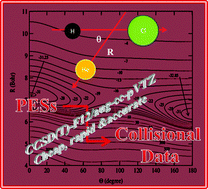We closely compare the accuracy of multidimensional potential energy surfaces (PESs) generated by the recently developed explicitly correlated coupled cluster (CCSD(T)-F12) methods in connection with the cc-pVXZ-F12 (X = D, T) and aug-cc-pVTZ basis sets and those deduced using the well-established orbital-based coupled cluster techniques employing correlation consistent atomic basis sets (aug-cc-pVXZ, X = T, Q, 5) and extrapolated to the complete basis set (CBS) limit. This work is performed on the benchmark rare gas–hydrogen halide interaction (HCl–He) system. These PESs are then incorporated into quantum close-coupling scattering dynamical calculations in order to check the impact of the accuracy of the PES on the scattering calculations. For this system, we deduced inelastic collisional data including (de-)excitation collisional and pressure broadening cross sections. Our work shows that the CCSD(T)-F12/aug-cc-pVTZ PES describes correctly the repulsive wall, the van der Waals minimum and long range internuclear distances whereas cc-pVXZ-F12 (X = D,T) basis sets are not diffuse enough for that purposes. Interestingly, the collision cross sections deduced from the CCSD(T)-F12/aug-cc-pVTZ PES are in excellent agreement with those obtained with CCSD(T)/CBS methodology. The position of the resonances and the general shape of these cross sections almost coincide. Since the cost of the electronic structure computations is reduced by several orders of magnitude when using CCSD(T)-F12/aug-cc-pVTZ compared to CCSD(T)/CBS methodology, this approach can be recommended as an alternative for generation of PESs of molecular clusters and for the interpretation of accurate scattering experiments as well as for a wide production of collisional data to be included in astrophysical and atmospherical models.

You have access to this article
 Please wait while we load your content...
Something went wrong. Try again?
Please wait while we load your content...
Something went wrong. Try again?


 Please wait while we load your content...
Please wait while we load your content...